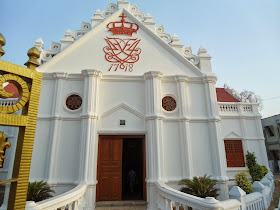A look at the world of politics, statecraft, diplomacy and books
Trnaquebar--Whose History? Transnational Cultural Heritage in a Former Danish Trading
Colony in South India
Helle Jorgensen
New Delhi, Orient Black Swan, 2014
Cultural Encounters in India: The Local Co-workers of the Tranquebar Mission 18th and 19th Centuries
Heike Liebau
New Delhi, Social Science Press 2014
The recent changes in historiographical fashion has left its mark on these two books. The post colonial obsession with identity, ideology and self-refashioning has contributed to the gradual erasure of colonialism as a violent and at times racist attack on the cultures of non- White peoples. Post colonial nostalgia and the distance from the colonial past has made some of the more comfortable Europeans look back at the past of their societies with a certain degree of pride and conscious self awareness. Tranquebar, a small trading post of the Danish East India Company on the East Coast of India, better known as the Coromandel coast, has had a checkered past; after the Napoleonic wars, the Danes essentially lost control over the trading post leaving a murky legacy of Christian evangelism, Slaving, Textile Trade and the most celebrated of all, the Printing Press. Print culture started in Traquebar and though there is some evidence to suggest that Serampore near Calcutta may have had an earlier start, the legacy of Tranquebar lives on both in popular memory and in scholarly texts.
In the first book, Helle Jorgensen looks at the interaction between the local population of Tranquebar and foreign tourists from Northern Europe who flood the place. Tranquebar has been the subject of a major experiment in restoration and conservation of the colonial buildings and tourists from Europe perceive a connect between their own subjective selves and the remote outpost of European settlement in Asia. Remarkably, the author seems to suggest that the presence of the old style European colonial buildings in the settlement are a boon to the local people whose economy revolves around catering to those tourists. Partly an ethnographic study and partly an extended reflection on the meaning and significance of heritage and its conservation, this book completely ignores the Indian perspective. While India no longer frets and fumes at European colonialism as a new generation which has come of age in the post Independence period does not regard the eighteenth and nineteenth century past with great trepidation. However, it is utterly condescending to write as if the local context does not matter at all. Worse, in the name of heritage and tourism, the past cannot be whitewashed and made palatable.
The second book is a more substantial contribution and it explores the relationship between the Lutheran Mission and its leadership in Tranquebar and the Tamil population it apparently ministered. Bartholmaus Ziegenbalg, the Protestant missionary is the subject of an excellent biography by B Singh. He is rightly remembered in India as the man who introduced Print and thereby brought about a revolution in the social and cultural history of India. He studies Tamil and within a couple of years of his stay was able to write psalms and catechisms or prayer books in simple Tamil for the people living in the hinterland of Tranquebar. His papers preserved at Halle give us a picture of a man driven by a deep and abiding faith in religion who did not forget his European identity throughout his stay in India. While the contemporary Jesuits went native and adopted Indian dress and customs, Ziegenbalg was always attired in the frock coat and top hat. He established a school where children were taught and even a factory for making paper. The site of this factory is unfortunately lost. He eventually dies in Tranquebar and is buried in the cemetry of the Zion Church which he built and consecrated. The book gives details of the relationship with other Christian missions in the region such as SPCK. The issue of caste and identity cannot be wished away as many of the early converts came from the Vellala peasant background and eventually the other castes joined the Church raising issues which the Christian Church both Catholic and Protestant have not resolved until this day.
Both these books are significant contributions to the study of the early colonial past of Southern India.
Tranquebar
The Fort facing the Coromandel Coast
Chinese Porcelain from Tranquebar
Danish Historical Documents
The Zion Church built by Ziegenbalg
The Restored mansion of the Governor







No comments:
Post a Comment